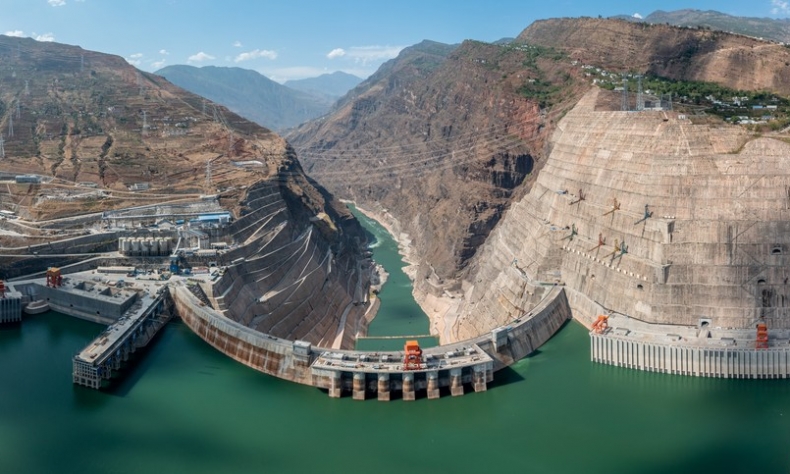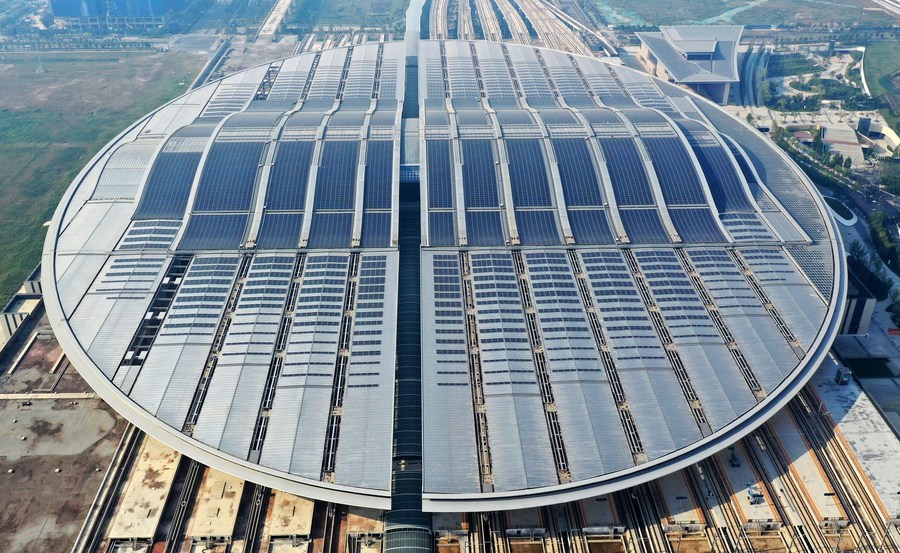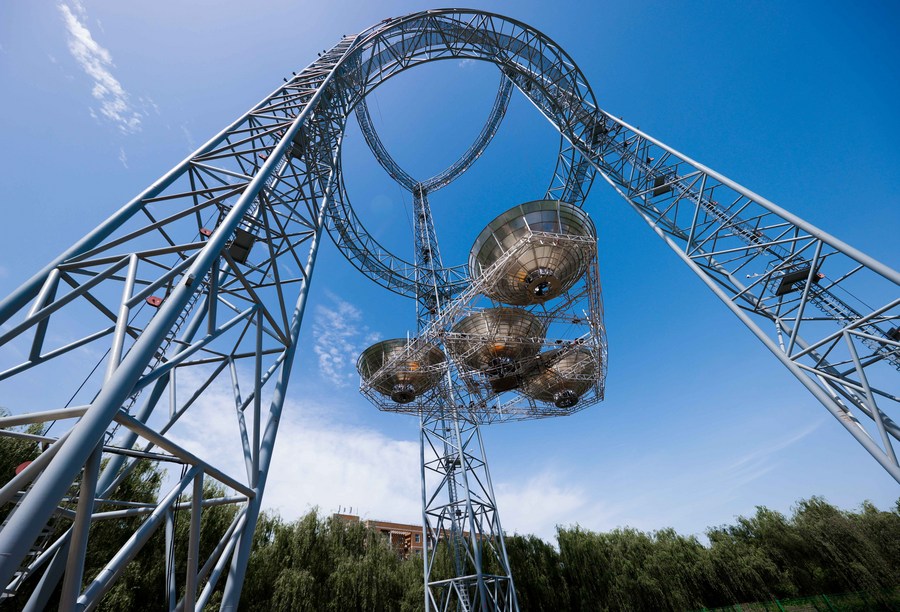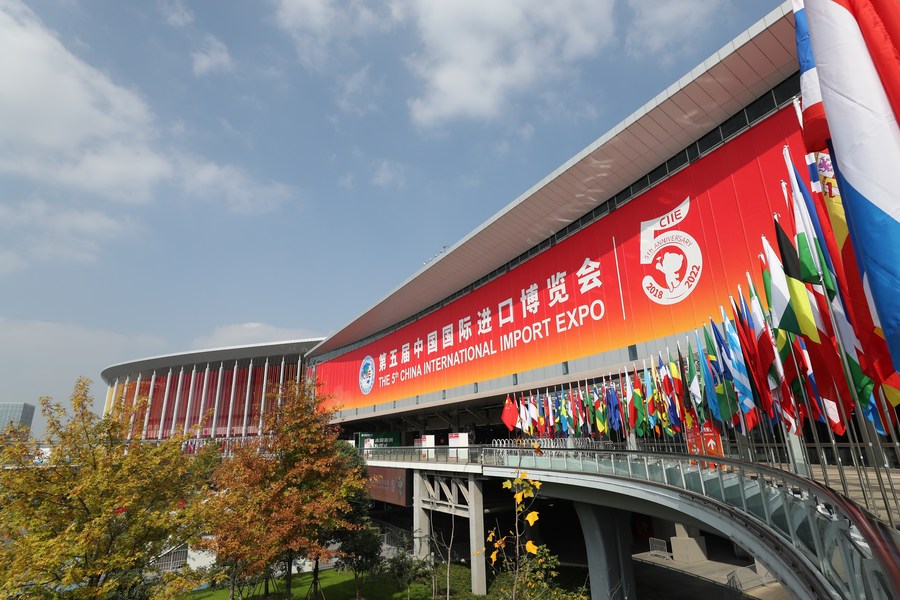International Players Tap into China’s Green Opportunities

China, as one of the world’s key economic engines, will continue to play a role in stabilizing the global economy in the post-pandemic era.
A team of Chinese engineers and their U.S. peers are currently working on their first commercial-scale energy storage and power generation project in Rudong County, Jiangsu Province, not far from Shanghai. The 100-megawatt-hour undertaking, with over $100 million in investment, is expected to enter operation in 2023.
When referring to it during the Third International Carbon Neutrality and Green Investment Conference in Shanghai on November 8, 2022, Neil Bush, Chairman of the George H.W. Bush Foundation for U.S.-China Relations, said, “To address climate change, we need to see many more such collaborations inviting the best technologies to be applied in China and globally.”
The project, which features giant concrete blocks, uses gravity to store and release renewable energy on demand, ensuring more reliability.
Bush added the foundation and his own business activities intend to bring parties together and forge diplomatic and business connections.
China’s goal of peaking carbon dioxide emissions before 2030 and achieving carbon neutrality before 2060 serves as a motivator of the technology collaboration, President of the U.S.-based National Center for Sustainable Development (NCSD) Eric Fang told Beijing Review.
Built by China Tianying (CNTY), an environmental management corporation, the Rudong project involves several international partners. In early 2022, Swiss energy storage developer Energy Vault signed a $50-million licensing agreement with Houston-based Atlas Renewable, CNTY’s holding subsidiary in the U.S., for the use of its technology and energy management software suite in China. The NCSD, for its part, provides policy interpretations and guidance.
“This is a perfect example of a market-driven opportunity featuring integrated policy, investment and technology support,” Fang added.

Market motivation
By late November last year, China’s total installed power generation capacity had reached 2.51 billion kilowatts (kw), rising 8.1 percent year on year, data from the National Energy Administration (NEA) showed.
The size of its energy market appeals to many overseas businesses. According to Xinhua News Agency, Siemens Energy AG announced the establishment of a subsidiary in Shenzhen at the 2022 Global Investment Promotion Conference for the Guangdong-Hong Kong-Macao Greater Bay Area in Guangzhou, Guangdong Province, on December 21. Previously, the German energy technology heavyweight had supplied 18 heavy-duty and 41 industrial-type gas turbines to the area. These turbines have a total installed capacity exceeding 10 gigawatts and help provide power to nearly 17 million households.
China’s renewable energy market continued its expansion in the January-November period last year amid the country’s dynamic pursuit of green development. By late November, the installed capacity of wind power grew 15.1 percent from a year earlier to 350 million kw, while that of solar power came in at 370 million kw, a yearly increase of 29.4 percent, according to the NEA.
China reaffirmed its support for technology innovation and green development at the annual Central Economic Work Conference in Beijing from December 15 to 16, 2022, where Chinese leaders set the country’s economic priorities for 2023.
China will expand import of advanced technology and forge new competitive advantages in its pursuit of carbon peaking and neutrality goals.
China’s ambitions in green development have provided energy industries with huge market opportunities. “Our growth plan is in line with China’s green development and carbon policies,” Fang said, adding he is seeing a tremendous renewable energy market.
“Energy storage and transition, decarbonization, hydrogen technology investment and the digital transformation of the manufacturing industry are also key growth sectors in China,” Fang added.

Apart from their promotion of gravity-based energy storage technology, Fang and his partners develop other industries such as wind, photovoltaic, hydrogen and ammonia energy.
Fang said their investment in this field runs into the hundreds of millions of U.S. dollars over the next three years. “Also, we hope to promote technology cooperation between China and the U.S. under their Joint Glasgow Declaration on Enhancing Climate Action in the 2020s,” he added.
The declaration, released at the UN Climate Change Conference in Glasgow, the UK, in April 2021, outlined priority areas for China-U.S. cooperation, including integration of solar, storage, and other clean power solutions.
China’s efforts in sustainable development also lend associated industries a helping hand. For example, Yasaki (China) Investment Corp., an automotive component maker, said at the Guangzhou investment fair that it is eyeing the robust development of China’s new-energy automobile industry and is ready to make new investments, according to Xinhua.
Ready to recover
Against the backdrop of a sluggish world economy and rising protectionism, China’s policymakers have reiterated their commitment to further opening up the country’s market. Proof of this pledge is the rise of foreign direct investment in the Chinese mainland, which went up 12.2 percent year on year to $178.08 billion in the first 11 months of 2022, the Ministry of Commerce said on December 23, 2022.
China will exert greater efforts to attract and utilize foreign capital, widen market access, promote the opening up of modern service industries, and ensure foreign-funded enterprises enjoy the same treatment as domestic businesses, an official news release issued at the conclusion of the Central Economic Work Conference said.
After China’s new COVID-19 response measures eased restrictions on social and economic activities in early December last year, many local governments organized fairs and sent delegations abroad to attract foreign investment, all the while boosting confidence in the country’s economic rebound. For example, the Guangzhou fair saw more than 800 projects involving investments worth 2.5 trillion yuan ($358 billion) inked.

A wide range of players provides substantial backing. According to Fang, the Rudong project has received support from the Chinese Embassy in the U.S. and the Investment Association of China. From the get-go, the NCSD has worked side by side with Neil Bush and his organizations to keep the embassy up to date on the project’s latest developments and the latter in turn helps facilitate communication with government agencies.
Fang, for one, is optimistic about China’s recovery given its optimized COVID-19 control policy. “It is an important step in supporting the country’s economic development and gradually returning to normal,” he said.
“Face-to-face engagement is crucial for international cooperation when it comes to consultations on technology collaboration, supply chain development and intellectual property protection,” he added.
The National Immigration Administration said China will resume accepting and approving Chinese citizens’ applications for passports for tourism and visiting friends abroad as of January 8. Services related to the application for ordinary visas, stay permits, and residence permits by foreigners will resume as well.
Han Wenxiu, Executive Deputy Director of the Office of the Central Committee for Financial and Economic Affairs, said on December 17, 2022 that the adjusted COVID-19 response will have a major positive impact on China’s economic recovery throughout 2023 despite short-term fluctuations, adding he believes the pace of recovery will accelerate in the first half of 2023, particularly in the second quarter, as economic vitality is unleashed.
“China, as one of the world’s key economic engines, will continue to play a role in stabilizing the global economy in the post-pandemic era,” Fang said.
 Facebook
Facebook
 Twitter
Twitter
 Linkedin
Linkedin
 Google +
Google +










